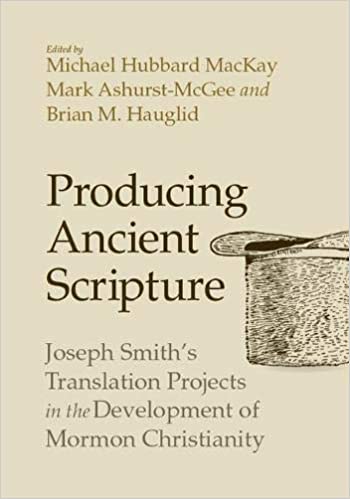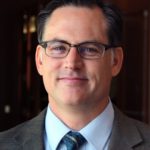
This book includes a mixture of scholarship about all of Joseph Smith’s translation projects, including the highly anticipated paper by Thomas A. Wayment and Haley Wilson-Lemmon on the use of the Clarke Commentary in the Joseph Smith Translation of the Bible. We had the opportunity to discuss the book with Michael Hubbard MacKay and Mark Ashurst-McGee. A review of the book will be forthcoming.
Q1: What is the purpose of the book?
Mike and Mark: The book was conceived as an attempt to cover all of the various Joseph Smith translation projects—not only the Book of Mormon and the “New Translation” of the Bible and the Book of Abraham but also the excerpt from the new account of John (D&C 7), the excerpt from the “record of John” (in D&C 93), the Kinderhook plates, and anything else. This had actually never been done before—at least not at this depth.
This objective of covering all of the projects is well reflected in the book’s Table of Contents. You can check it out here:
https://uofupress.lib.utah.edu/producing-ancient-scripture/
Q2: Who is the audience?
Mark and Mike: The book is written for a scholarly audience. So, to be clear, the chapters are not arguing for or against the antiquity of the translation texts. While most of the contributors are observant and believing church members, others are disaffected or never had been church members. All, however, are friendly to our faith and have offered their contributions of scholarship toward helping to increase what can be known about the modern historical aspects of Smith’s translation projects. The chapters are intended to be something that any scholar could read and appreciate, whether members of the Church or not.
In this Q&A, we have a responsibility to represent both the member and nonmember scholars who contributed to Producing Ancient Scripture. But, here in this particular venue, we will also be able to speak as believing Latter-day Saints. We’ll try to signal which hat we’re wearing as we give our responses to the various (and challenging) questions posed here.
Q3: There seems to be a wide range of orthodoxy represented by the various contributed chapters. How did you select which ones to include?
Mark: If we were trying to represent the wide range of orthodoxy (and heterodoxy) found in Mormon studies, we would have tried to conscript at least one scholar from the Community of Christ, another scholar from one of the other Restoration churches (maybe a Strangite like Bill Shepard or a Bickertonite like Daniel P. Stone), and maybe even a Utah fundamentalist (like Anne Wilde).
Instead, we selected the contributors based on their subject expertise. We wanted to cover all of the translation projects (see Q1 above), so we made a list of the various projects, figured out who would be good to engage, and went from there.
A few of the initial submissions were turned down because they didn’t quite fit the book’s purpose. None of the submissions were included or excluded based on any standards of orthodoxy. There were a few places here and there in the chapters where, as an editor, I worked with the authors to revise language that was either asserting or ruling out divine revelation. But this was very rare. All of the submissions were written in a scholarly style that was aimed at other scholars, whether believing Latter-day Saints or otherwise.
As noted in the answer to Q2, above, we wanted the book to be something that could be appreciated by anyone of any faith (or no faith). Insofar as there is a wide range of orthodoxy (or even heterodoxy) represented by the various contributed chapters, it is an organic reflection of the various kinds of scholars engaged in Mormon studies at this moment in time.
Q4: The book includes a chapter by Brian Hauglid, a former professor of Ancient Scripture in the College of Religious Education at BYU. Hauglid recently retired and then announced in a podcast that he no longer believed that the Book of Mormon and the Book of Abraham are ancient. Moreover, he seems to imply that this has been his position for some time now. Is this the position taken in his chapter on the Book of Abraham?
Mike: In Brian Hauglid’s chapter, the main argument is that there are parts of the Book of Abraham that rely upon parts of the Egyptian language study documents. I think he does a good job exploring the evidence and context, and his conclusions are very tentative. Also, he does not rule out the possibility of translation by revelation. I don’t think there is an ulterior motive to get readers to arrive at a position of doubt. It’s much more a work of scholarship than of religious politics.
Q5: The book includes a chapter by Thomas A. Wayment and Haley Wilson-Lemmon arguing that Joseph Smith drew on Adam Clarke’s Bible commentary for some of the changes in the Joseph Smith Translation of the Bible. Wilson-Lemmon has recently participated in a podcast in which she presents this apparent use of Clarke’s commentary as plagiarism. How does one resolve concerns regarding the JST chapter?
Mark: Haley Wilson-Lemmon considers Joseph Smith’s use of Adam Clarke’s Bible commentary as “plagiarism.” Thomas A. Wayment does not. In his recent article in the Journal of Mormon History, Wayment presents Smith’s study of Clarke as an example of Smith following the revelation to “seek . . . out of the best books words of wisdom; seek learning, even by study and also by faith” (D&C 88:118). Wayment also points out how selectively Smith drew upon Clarke and seems to implicitly argue that this utilization was not simple borrowing. So, different people will arrive at different conclusions on this one.
Some have taken issue with detractors using the word “plagiarism,” arguing that it is anachronistic. I have not yet looked into the history of the usage and cultural connotations of that word for myself.
My main problem with asserting plagiarism is that we do not know how Joseph Smith would have presented his borrowings from Clarke. Although Joseph Smith intended to publish the JST, this was never accomplished (in his lifetime). All of the Joseph Smith-era books published by the Church (the Book of Mormon, the Book of Commandments, the Doctrine and Covenants, and the hymnal) included introductory content. If the JST had been published, it would have almost certainly included similar introductory content. Moreover, a version of the Bible that differed from the culturally sacrosanct text of the King James Version would have had at least some explaining to do. This may well have included a blanket attribution to Clarke’s commentary for some of the changes. Again, based on the publishing precedents, we can safely surmise that the JST would have had an introduction, and we just don’t know what it would or would not have explained. The charge of plagiarism rests upon the assumption that Smith would have presented everything as his own or as pure revelation. I have almost completed an article on this that I hope to publish soon.
Q6: Besides the chapter on the Joseph Smith Translation, what other chapters would be of the most interest to readers of the FairMormon blog and why?
Mike: Gerrit Dirkmaat contributes a chapter on the termination of the Joseph Smith Translation that focuses on Smith’s revelation regarding the Apocrypha. Toward the completion of revising the Old and New Testaments, Smith prayed to know whether he should carry the JST on into the Apocrypha. This chapter is an interesting complement to the chapter by Wayment and Wilson-Lemmon.
Mark: The chapter by Matthew Grey shows quite clearly that Joseph Smith drew upon his Hebrew textbooks for the Hebrew words that appear in the Book of Abraham. Grey lays out the evidence for this far better than anyone else ever has, and he does a great job of placing this usage within the context of Joseph Smith’s Hebrew study and his translation efforts. The findings in this chapter will certainly be used (and abused) by detractors, so it would be good for FairMormon apologists and followers to know that the evidence comes from an article (or, rather, a chapter) that contextualizes this evidence in a way that does not undermine Joseph Smith as a translator.
Mike: I think that readers of this blog would also be interested in the final chapter in the book, on the Kinderhook plates, which shows quite clearly that Joseph Smith attempted to translate from the Kinderhook plates as a secular effort, and that he did so openly in the presence of both church members and nonmembers.
Mark: Oh, and I would also recommend all of the other chapters too!
Q7: What misconceptions about chapters in this book should believers be aware of and avoid falling trap to?
Mike: Well, we appreciate being invited to do this Q&A because we do think that many of your readers will be interested in the scholarship contained in Producing Ancient Scripture. However, we should also clarify that this is not a work of devotional or apologetic history. More than anything, it fits within the genre, style, and academic tenor of American religious history.
Mark: Some of it will probably be found to be of some use in apologetics (like the chapter that Don Bradley and I contributed on the Kinderhook plates), but other chapters will be probably be used (or, rather, abused) by detractors (such as the chapters on the JST and the Book of Abraham). Some chapters, like the one on the involvement of women in the translation of the Book of Mormon, are very insightful but do not really lend themselves to either attacking or defending the faith. The various contributors studying the various translation projects came up with various findings, with the chips falling here, there, and everywhere. I think anyone with a deep interest in Joseph Smith’s translation projects would like to learn about these new findings, whether or not they affirm faith. Going back to the chapter on women and the translation of the Book of Mormon, I’d say that many faithful Latter-day Saints would really like this one. I think there’s lots to learn from in the book.
Q8: Is there a need to loosen definitions of literal or historical truth going forward?
Mark: To my view, this is already being effectively accomplished in scholarship produced by the Church, FairMormon, the Maxwell Institute, the Interpreter, Book of Mormon Central, and several other outlets producing faithful scholarship. For example, the Book of Mormon includes mention of pre-Columbian horses. Many apologists have offered an explanation that in this case, the English word “horse” should not be understood as a rigid and literal cognate-to-cognate translation, but should be more loosely understood as a case of loan shifting or utilizing an “expanded” (and thus loosened) definition.
To give another example, Bill Hamblin, Daniel Peterson, and John Gee have explicated what appears to be geocentric astronomy in the Book of Abraham, pointing to this as an evidence of the text’s antiquity and historicity. This, however, requires modern (post-Copernican) readers to loosen up our reading of Abraham’s astronomical visions. I’m pretty sure that Hamblin, Peterson, and Gee are not trying to convert us to a geocentric model of the cosmos. Rather, we have to understand Abraham’s astronomical visions within their cultural context and not as “literal” explications of actual astronomical mechanics.
Of course, if you loosen the definition of historical or literal truth too much it become vacuous and meaningless. So, there are limits, to be sure. And, of course, these limits are hotly contested.
I think that maybe I am rambling here, so back to the question. I guess my answer would be this: No, there is not a need to loosen definitions of literal or historical truth going forward. This is because we are already doing this and have been doing so for decades now. And we are getting better at it, too. And we need to continue doing it, and doing it as carefully as we can, in both neutral scholarship and honest apologetics.
Q9: How does the methodology present within this book show a pivot in the future of Latter-day Saint scholarship? Should there be a pivot?
Mark and Mike: I think we are too close to the book to answer this one. We’ll wait and see what others think. Perhaps this is a good place to start a wider conversation.
 Michael Hubbard MacKay is an associate professor in the Department of Church History and Doctrine at Brigham Young University. He is also a former historian at the Joseph Smith Papers Project and co-editor of Volume 1 in the Documents series. He is the author of Prophetic Authority: Democratic Hierarchy and the Mormon Priesthood (University of Illinois Press, 2020) and Sacred Space: Exploring the Birthplace of Mormonism (RSC, Brigham Young University, 2015). He is also the co-author of Joseph Smith’s Seer Stones (RSC, Brigham Young University, 2016) and From Darkness Unto Light: Joseph Smith’s Translation and Publication of the Book of Mormon (RSC, Brigham Young University, 2015).
Michael Hubbard MacKay is an associate professor in the Department of Church History and Doctrine at Brigham Young University. He is also a former historian at the Joseph Smith Papers Project and co-editor of Volume 1 in the Documents series. He is the author of Prophetic Authority: Democratic Hierarchy and the Mormon Priesthood (University of Illinois Press, 2020) and Sacred Space: Exploring the Birthplace of Mormonism (RSC, Brigham Young University, 2015). He is also the co-author of Joseph Smith’s Seer Stones (RSC, Brigham Young University, 2016) and From Darkness Unto Light: Joseph Smith’s Translation and Publication of the Book of Mormon (RSC, Brigham Young University, 2015).
 Mark Ashurst-McGee is a senior historian in the Church History Department and the senior research and review editor for the Joseph Smith Papers, where he also serves as a specialist in document analysis and documentary editing methodology. He holds a PhD in history from Arizona State University and has trained at the Institute for the Editing of Historical Documents. He has coedited several volumes of The Joseph Smith Papers and is also coeditor of Foundational Texts of Mormonism: Examining Major Early Sources (Oxford University Press, 2018). He is also the author of several articles on Joseph Smith and early Latter-day Saint history published in scholarly journals and popular venues.
Mark Ashurst-McGee is a senior historian in the Church History Department and the senior research and review editor for the Joseph Smith Papers, where he also serves as a specialist in document analysis and documentary editing methodology. He holds a PhD in history from Arizona State University and has trained at the Institute for the Editing of Historical Documents. He has coedited several volumes of The Joseph Smith Papers and is also coeditor of Foundational Texts of Mormonism: Examining Major Early Sources (Oxford University Press, 2018). He is also the author of several articles on Joseph Smith and early Latter-day Saint history published in scholarly journals and popular venues.
The post Q&A with editors of Producing Ancient Scripture: Joseph Smith’s Translation Projects in the Development of Mormon Christianity appeared first on FairMormon.
Continue reading at the original source →



